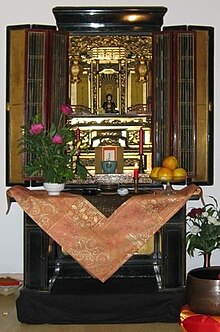This is an old revision of this page, as edited by Jarble (talk | contribs) at 18:26, 20 September 2012 (wikifying). The present address (URL) is a permanent link to this revision, which may differ significantly from the current revision.
Revision as of 18:26, 20 September 2012 by Jarble (talk | contribs) (wikifying)(diff) ← Previous revision | Latest revision (diff) | Newer revision → (diff)
A butsudan (佛壇 or 仏壇, literally "Buddha altar") is a shrine commonly found in temples and homes in Japanese Buddhist cultures. A butsudan is a wooden cabinet with doors that enclose and protect a gohonzon or religious icon, typically a statue or painting of a Buddha or Bodhisattva, or a "script" mandala scroll. The doors are opened to display the icon during religious observances, and closed before sunset. A butsudan usually contains an array of subsidiary religious items, called butsugu, such as candlesticks, incense burners, bells, and platforms for placing offerings such as fruit, tea or rice. Some Buddhist sects place ihai, memorial tablets for deceased relatives, within or near the butsudan.
Arrangement
The arrangement and types of items in and around the butsudan can vary depending on the sect. A butsudan usually houses a statue or painting of the Buddha or a Buddhist deity, though embroidered scrolls containing a mantric or sutric text are also common. Other auxiliary items often found near the butsudan include tea, water and food (usually fruits or rice), an incense burner, candles, flowers, hanging lamps and evergreens. A rin gong or "singing bowl" often accompanies the butsudan, which can be rung during liturgy or recitation of prayers. Members of some Buddhist sects place ihai or tablets engraved with the names of deceased family members within or next to the butsudan. Other Buddhist sects, such as Jōdo Shinshū, usually do not have these. The butsudan is typically placed upon a larger cabinet in which are kept important family documents and certificates.
Social-spiritual relations
The butsudan is commonly seen as an essential part in the life of a traditional Japanese family as it is the centre of spiritual faith within the household, especially in dealing with the deaths of family members or reflecting on the lives of ancestors. This is especially true in many rural villages, where it is common for more than 90% of households to possess a butsudan, to be contrasted with urban and suburban areas, where the rate of possession can drop down to below 60%.
See also
Notes
- Reader (1995:55) notes: "Over 60% of Japanese households have a butsudan: many of the rest do not simply because no-one in the family has yet died and become an ancestor".
- Cf. Reader (1995:55-56); Lewis (2007:178).
- Cf. Buckley (2002:56-57).
- Cf. Hamabata (1990:61).
- See Nakamaki (2003:24-25) for a discussion of the sociological stratification of butsudan ownership in modern Japan.
References
- Buckley, Sandra (2002) "Butsudan and Kamidana" in Buckley, Sandra (Ed.) Encyclopedia of Contemporary Japanese Culture, pp. 56–57. London: Routledge. ISBN 0-415-14344-6.
- Hamabata, M. Masayuki (1990). Crested Kimono: Power and Love in the Japanese Business Family. New York: Cornell University Press. ISBN 0-8014-2333-3.
- Lewis, Todd T. (2007). "Butsudan" in Espin, Orlando (Ed.) An Introductory Dictionary of Theology and Religious Studies, pg. 178. Collegeville: Liturgical Press. ISBN 978-0-8146-5856-7.
- Nakamaki, Hirochika (2003). Japanese Religions at Home and Abroad. New York: Routledge/Curzon. ISBN 0-7007-1617-3.
- Reader, Ian (1995). Japanese Religions: Past and Present. Honolulu: University of Hawaii Press. ISBN 0-8248-1545-9.
| Elements of Japanese architecture | ||||||||||
|---|---|---|---|---|---|---|---|---|---|---|
| Styles |
|  Model of Himeji Castle | ||||||||
| Types of building |
| |||||||||
| Roof styles | ||||||||||
| Structural and spatial | ||||||||||
| ||||||||||
| Rooms | ||||||||||
| Furnishings | ||||||||||
| Partitions | ||||||||||
| Outdoor objects | ||||||||||
| Measurements | ||||||||||
| Organizations | ||||||||||
| Related topics |
| |||||||||